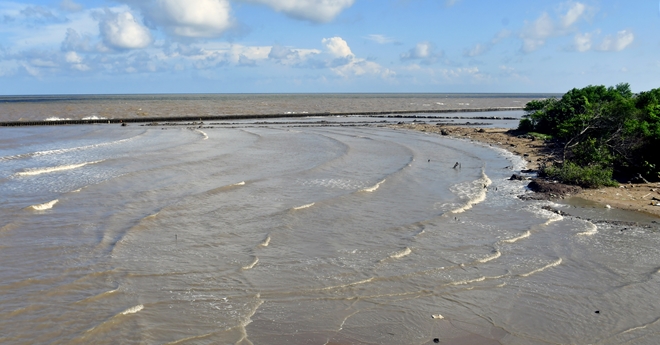The West Coast was eroded with a length of about 57km, in which many sections no longer have protection forests, or the protection forest belt is only a few tens of meters. Currently, the situation of landslides on the West Coast is becoming more and more dangerous. The coastal protection forests gradually disappear, so the West Sea dyke is often threatened by strong waves and high winds, the risk of dyke breaking is very high, especially in the rainy season, the southwest wind is active and the tide is high. rise high.
According to the Department of Agriculture and Rural Development of Ca Mau province, from June 2 to 8 in the province, there were 39 landslides along rivers and coastal areas with a total length of more than 810m (including 199m of concrete roads), causing damage to 19. house, damaged 3 houses, 3 shrimp hatcheries, fell 2 electric poles...

Sea waves pass through the embankment, erode and cause landslides of the protective forest belt in Tran Van Thoi district
Mr. Le Van Su, Vice Chairman of Ca Mau Provincial People's Committee, said that with the increasing occurrence of coastal erosion, the Provincial People's Committee has issued many urgent decisions on dyke protection; mobilize all efforts, including businesses located in the area, to focus on dealing with landslides, minimizing damage caused by natural disasters, helping people to soon restore production and stabilize their lives. In particular, with a drastic spirit, the province has implemented many solutions to handle landslides. In addition to non-structural solutions (such as organizing migration and resettlement; launching a movement to plant trees and create forests; organize monitoring of coastal landslides in terms of scale, intensity, and direction of displacement according to regulations). period...), the province focuses on construction solutions to solidify sea dykes, anti-erosion embankments, cause accretion, restore coastal mangroves,...
Currently, Ca Mau has implemented these solutions with a total length of nearly 49km (40km of West Sea dyke and 9km of East Sea dyke). According to the latest survey data, behind the work, alluvial ground has formed, which is continuously filled year by year. The average height of the yard is raised from 1 to 1.5m of alluvium compared to before the construction. Along with promoting the effect of reducing waves and causing accretion, the project also creates good conditions for mangrove regeneration, ensuring the safety of residential houses inside the dike as well as agricultural production of the people.
In order to implement structural and non-structural solutions to cope with coastal erosion in the coming time, the province proposes to the Government to direct the Ministry of Finance not to apply the on-lending mechanism for ODA projects for projects that respond to coastal erosion. natural disaster, which is applied the central budget mechanism to allocate the entire amount of ODA invested for projects on construction of sea dykes, construction of embankments to create land to restore protective forests to prevent coastal erosion, to respond to natural disasters. climate change, because these projects are not likely to recover capital.
In particular, it is recommended to the Prime Minister and central ministries and branches to consider having a mechanism to mobilize capital from enterprises to invest in building embankments to create yards to restore coastal protection forests, in combination with investment in exploitation of natural resources. ecotourism exploitation, wind power, solar power (enterprises invest in embankments and are assigned to use coastal protection forest land recovered from the project for ecotourism business).
Along with that, the Central Government will soon allocate funds to Ca Mau province to deal with riverbank and coastal erosion and dredging sedimented estuaries and sea mouths with a total cost of about 1,047 billion VND, of which priority Funding for treatment of urgent and especially dangerous anti-erosion works is nearly 800 billion VND and funding for dredging estuaries and sea mouths that are deposited before the rainy season in 2021 is about 250 billion VND.